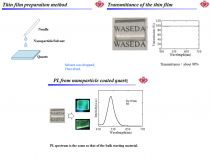Fabrication of Nanoparticle Phosphor Film and Solar Cell Applications

- researcher's name
- affiliation
- research field
-
Inorganic materials/Physical properties,Electronic materials/Electric materials,Biomedical engineering/Biomaterial science and engineering
- keyword
-
background
Solar power is attracting attention as a clean and renewable energy and is a subject of much research. At our laboratory, the focus of research is on silicon solar cells which have a high conversion efficiency and a high share. The spectral sensitivity of silicon solar cells and the spectrum of solar light are not in congruence. Consequently, silicon solar cells cannot make effective use of short-wavelength light of around 400nm. We made improvements to cope with this problem, converted short-wavelength light into long-wavelength light, and made effective use of short-wavelength light which is low sensitivity for solar cells.
Our laboratory fabricates nanoparticle phosphor films, assesses their characteristics, and researches solar cell applications.
summary
Our laboratory made nanoparticle phosphors of several nm using the ball mill method. Transparent thin film with over 90% transmittance in all wavelength regions was fabricated using nanoparticle phosphors.
Red phosphor transparent thin film that meets the following conditions is fabricated on the solar cell.
(1) Short-wavelength light is converted to long-wavelength light
(2) Long-wavelength light is transmitted as is (→using nanoparticles)
The following two types of materials are used as red phosphors.
・Sulfide phosphor Ba2ZnS3: Mn (BZS)
・Nitride phosphor CaAlSiN3: Eu (CASN)
Research has long been conducted on sulfide phosphors. Our laboratory can turn sulfide phosphors into nano sizes of several nm by the ball mill method, and used them to fabricate transparent thin film with dispersing quality and high transmittance.
Nitride phosphors have superior luminous efficacy and durability compared with oxides and sulfide phosphors. Accordingly, our laboratory is studying the conditions for turning nitride phosphors into nano sizes, and was able to obtain particles of several tens of nm that conduct wavelength conversion.
We found that a transparent thin film was fabricated on the photodiode and that wavelength conversion was achieved in a short-wavelength light region.
application/development
The film may be used for various purposes, such as crime prevention and security purposes, by attaching multi-color nanoparticle phosphors.
It may be possible to enhance the luminescence intensity by improving the nanoparticle fabrication conditions.
Large nanoparticles are mixed in on the transparent thin film, and we found there was some cohesion. If the size and cohesion of nanoparticles can be further controlled, then there will be room for further transmittance improvements. If this is achieved, transparent thin film for wavelength conversion with even greater efficiency may be fabricated, and their applications will expand.
predominance
Nanoparticle phosphor films may be mass-produced at low cost. They utilize safe materials and are therefore also environmentally friendly.
purpose of providing seeds
Sponsord research, Collaboration research, Technical consultation
material
posted:
2014/05/21




